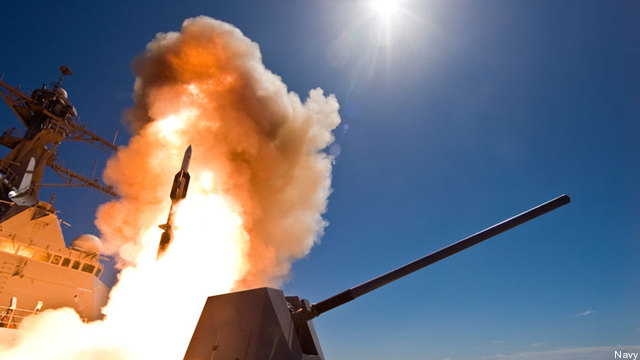Navy Cyber Chief: Budget Crunch Will Drive Innovation, Force Jointness
Posted on

WASHINGTON: Since 9/11, the armed services have made great strides in applying information technology to warfare — but their implementation to date has relied on costly, manpower-intensive “brute force,” said the Navy’s director for “information dominance,” Rear Adm. William Leigher. As budgets tighten, he said, the services will have no choice but to operate more efficiently and, above all, more cooperatively with one another.
“This is going to force us to take a different approach with jointness,” Leigher told the audience at an Armed Forces Communications and Electronics Association (AFCEA) luncheon yesterday. Under the growing fiscal pressure, he said, consolidation of separate networks to a single “joint information environment [JIE] becomes more possible in this downturn … than it might have been.”
It’s hard to think about the future, though, when you don’t know how much money you’ll have next month. With the automatic cuts known as sequestration set to start March 1st, and the Continuing Resolution funding the government expiring March 27th, all the services are frantically cutting back on costs. That includes conferences and speaking engagements requiring travel: “For those of you who expected a panel, I’m your panel,” said Leigher, the sole speaker left on the day’s agenda.
The real near-term damage is to military readiness, with the Navy canceling ship maintenance and even deployments overseas — most dramatically of the aircraft carrier USS Truman. But modernization programs will feel the pain as well, said Leigher: While major procurements are often funded years in advance, smaller improvements are routinely installed during maintenance “availabilities” now being cancelled.
For example, eight warships won’t be upgraded as scheduled with a new shipboard network called CANES (Consolidated Afloat Networks and Enterprise Services). That’s a single system meant to replace the no less than five separate networks, each serving a different purpose, currently installed on the typical warship.
Five networks on one ship is just a simple example of the inefficient kludges characteristic of today’s military information technology. Information pouring back from high-tech drones, for example, hits a low-tech chokepoint at analysis centers doing the “processing, exploitation, and dissemination” (PED), Leigher said, where the chief method of sifting through that data is entire rooms full of “22-year-old sailors” sitting and staring at screens for hours, watching for the one moment of life-or-death significance in hours of data.
“We throw people at the problem,” said Leigher. “People are the most expensive thing [in the military budget]. There’s got to be different ways we can attack this.”
What the military really needs is “better artificial intelligence,” said Leigher, able to sort through the information overload, identify patterns and anomalies, and only pass what matters on to the human analysts.
The ultimate goal, said Leigher, is a single seamless network sharing intelligence, targeting data, and commands among manned and unmanned assets from every service — yet without today’s dependence on satellite communications systems that can be hacked or shot out of orbit by a high-tech adversary (translation: China).
After decades of the Navy thinking about platforms — ships, planes, satellites — “I’m seeing the change,” said Leigher: “We really are talking about network warfighting capbilities” in a way the military wasn’t just a few years ago. And that change goes across services, especially between the Navy and the Air Force under their AirSea Battle initiative. “You really can’t look at this in a vacuum with the Navy,” he said, but instead must build in links to joint air operations centers and to so-called “5th generation” fighters like the Air Force F-22 and the F-35, which the Air Force, Navy, and Marines will all fly.
One project Leigher singled out was the awkwardly named NIFC-CA (pronounced “Nifca”), short for Naval Integrated Fire Control – Counter Air. Intended to coordinate defense against incoming enemy aircraft and missiles, NIFC-CA was begun to connect Navy fighters, shipboard radars, missile launchers, and reconnaissance aircraft like the E-2C. In September, however, the Navy and Army ran a test together at White Sands Missile Range, New Mexico, where a NIFC-CA connection allowed a Navy SM-6 Standard missile to intercept a target using data from an Army radar blimp called JLENS (Joint Land Attack Elevated Netted Sensor).
That kind of connectivity, Leigher said, “is really the first time we’ve approached what AirSea battle talks about, network integrated attack.”
Ultimately, the admiral said, the cutting edge of the new combat network will be unmanned platforms that can fight, not just collect intelligence. “This is where it all comes together,” he said, showing a slide of the experimental X-47 drone: artificial intelligence, weapons, targeting, command and control, and networks with the bandwidth to tie it all together.
At the same time, Leigher acknowledged, America’s omnipresent new technology creates a vulnerability as well — one that will require constant effort to secure. “These things,” he said, holding up his smartphone, “will keep me in business forever.”
And the challenges aren’t just technological. “Where I feel a little bit uncomfortable, as a guy that grew up in the intelligence community, is about what this means for privacy,” Leigher said. “We’ve got to be very careful as we go forward to protect individual rights, because it’s very easy to cross the line.”
Edited at 9:40 am, Feb. 21 to add term “Processing, Exploitation, & Dissemination.”
Subscribe to our newsletter
Promotions, new products and sales. Directly to your inbox.
